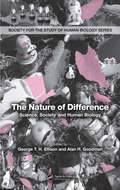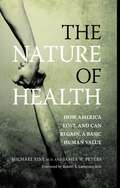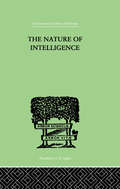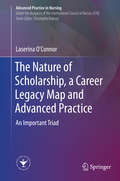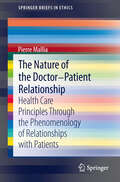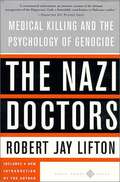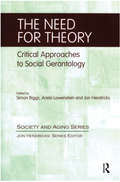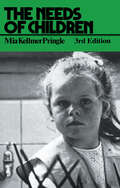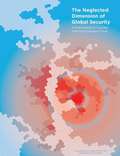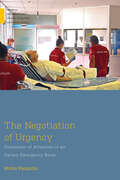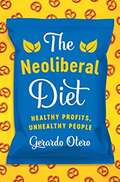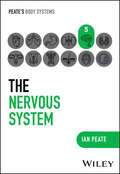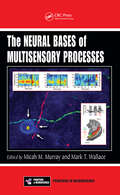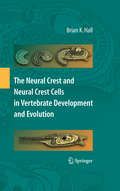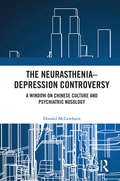- Table View
- List View
The Nature of Animal Healing: The Definitive Holistic Medicine Guide to Caring for Your Dog and Cat
by Martin GoldsteinGoldstein (D. V. M. , Cornell U. College of Veterinary Medicine) espouses a holistic approach to pet care and argues that conventional methods can cause or complicate ill health in pets. Writing primarily for the concerned pet owner, he offers alternatives to commercial pet foods and presents examples of various symptoms he's successfully treated with holistic methods. The book includes an extensive annotated resource guide that comprises listings of product manufacturers as well as excerpts from Helen McKinnon's book citing printed materials, web sites, associations, and veterinarians sympathetic to the cause. Annotation c. Book News, Inc. , Portland, OR (booknews. com)
The Nature of Difference: Science, Society and Human Biology (PBK) (Society for the Study of Human Biology)
by Alan H. Goodman George T. H. EllisonUnprecedented advances in genetics and biotechnology have brought profound new insights into human biological variation. These present challenges and opportunities for understanding the origins of human nature, the nature of difference, and the social practices these sustain. This provides an opportunity for cooperation between the biological and s
The Nature of Health: How America Lost, and Can Regain, a Basic Human Value
by James Peters Michael FineThis pioneering work addresses a key issue that confronts all industrialised nations: How do we organise healthcare services in accordance with fundamental human rights, whilst competing with scientific and technological advances, powerful commercial interests and widespread public ignorance? "The Nature of Health" presents a coherent, affordable and logical way to build a healthcare system. It argues against a health system fixated on the pursuit of longevity and suggests an alternative where the ability of an individual to function in worthwhile relationships is a better, more human goal. By reviewing the etymology, sociology and anthropology of health, this controversial guide examines the meaning of health, and proves how a community-centred healthcare system improves local economy, creates social capital and is affordable, rational, personal, and just. "This is badly needed nourishment for a medical system glutted on technology, individualism, profit and the pursuit of longevity. Read and be fed." - Christopher Koller, Health Insurance Commissioner, The State of Rhode Island, USA. "Unique. Surprising. A real eye-opener. Just about everyone who doesn't have a vested financial interest in maintaining the status quo will agree that U.S. healthcare is badly broken. [This book] is making it possible for us to refocus from how to provide healthcare to how to achieve health. Their description of health as successful functioning in community, rather than as a measure of longevity is a definition that can make a reader feel healthier as they take gradually appreciate the power of the concept. On this foundation, it is not as hard as one might think to outline a healthcare system that is equitable, affordable and achievable." - Alexander Blount EdD, Professor of Family Medicine, University of Massacusetts Medical Center.
The Nature of Intelligence (International Library Of Psychology Ser.)
by Thurstone, L LFirst Published in 1999. Routledge is an imprint of Taylor & Francis, an informa company.
The Nature of Learning: In Its Relation to the Living System (International Library Of Psychology Ser. #Vol. 41)
by George HumphreyThis is Volume IV in a series of twenty-one in a collection on Cognitive Psychology. Originally published in 1933, this looks at the nature of learning in its relation to the living system. In order to discover the mechanism of the living system, itis necessary to investigate which among its effects are connected with well-established laws of chemistry and physics and to distinguish them carefully from the effects which have no immediate, or at least known, relation with these laws, and of which the cause is concealed for us.
The Nature of Nutrition: A Unifying Framework from Animal Adaptation to Human Obesity
by David Raubenheimer Stephen J. SimpsonThe first book to address nutrition's complex role in biologyNutrition has long been considered more the domain of medicine and agriculture than of the biological sciences, yet it touches and shapes all aspects of the natural world. The need for nutrients determines whether wild animals thrive, how populations evolve and decline, and how ecological communities are structured. The Nature of Nutrition is the first book to address nutrition's enormously complex role in biology, both at the level of individual organisms and in their broader ecological interactions.Stephen Simpson and David Raubenheimer provide a comprehensive theoretical approach to the analysis of nutrition—the Geometric Framework. They show how it can help us to understand the links between nutrition and the biology of individual animals, including the physiological mechanisms that determine the nutritional interactions of the animal with its environment, and the consequences of these interactions in terms of health, immune responses, and lifespan. Simpson and Raubenheimer explain how these effects translate into the collective behavior of groups and societies, and in turn influence food webs and the structure of ecosystems. Then they demonstrate how the Geometric Framework can be used to tackle issues in applied nutrition, such as the problem of optimizing diets for livestock and endangered species, and how it can also help to address the epidemic of human obesity and metabolic disease.Drawing on a wealth of examples from slime molds to humans, The Nature of Nutrition has important applications in ecology, evolution, and physiology, and offers promising solutions for human health, conservation, and agriculture.
The Nature of Pandemics
by Candace J. Gibson Dag K.J.E. von LubitzThe ongoing COVID-19 disaster―and the universal realization of the inevitability of even worse pandemics in the future―has resulted in a wealth of books, scientific papers, and journalistic analyses of the politics, medicine, and human suffering. The Nature of Pandemics is not an outcrop of COVID-19 publication frenzy. Conceived in the period between the outbreaks of SARS and Ebola, the book addresses the critical, but commonly overlooked issues that limit readiness, recognition, and rapid response to emerging biodisasters. The book is unique in its approach to pandemics. It offers a holistic view of the nature of pandemics as a phenomenon, and of the challenges involved in mounting an organized, concerted response to a worldwide lethal bioevent. Most healthcare professionals at national and international levels recognize the danger; the political efforts to establish consistently effective countermeasures are sporadic and dissonant when they do occur. The slow and politically safe approach, the failure to react quickly, and unhesitatingly mobilize all resources, remain the paramount obstacles to the effective containment of a pandemic. The individual chapters of the book are written by internationally respected experts from Africa, Europe, and North and South America. The contributing authors represent a cross-section of professions involved in counter-pandemic activities: some operate at the highest levels of national and international institutions, others work as clinicians specializing in infectious diseases, scientists, experts in public health, law and its enforcement, or military aspects of pandemics. Their contributions, often highly personal and perhaps even controversial—supported by their involvement in the "front-line" challenges of pandemic containment and mitigation—provide a rare combination of first-hand knowledge of the current "state of the art" and recommendations for the implementation of best practices. The Nature of Pandemics offers multifaceted insight into problems that, if ignored initially, come to mar all subsequent response and mitigation efforts. The content spans solutions to developing readiness and mobilizing response as much to the current pandemic as to the future ones. Addressing government-generated roadblocks to response, military and security issues, global supply chain infrastructure, communications, information technology, ethical dilemmas posed by vacillating quality of care—and the inevitable mass fatalities—together with the confused interaction of global health organizations and response agencies, the book examines the panoply of complexities not only at the center of a pandemic outbreak but also at its equally critical and deadly periphery.
The Nature of Scholarship, a Career Legacy Map and Advanced Practice: An Important Triad (Advanced Practice in Nursing)
by Laserina O'ConnorThis book, endorsed by the International Council of Nurses, explores a new conversation around scholarly talents for advanced candidate /nurse practitioners that comprise a variety of forms such as teaching, synthesis, discovery, engagement and application. It offers an expansive view of Boyer’s scholarship, with a call to action for advanced candidate /nurse practitioners to thoughtfully plan and map their personal goals and capabilities, that will mark them as professionals and future scholars needed in today’s challenging and changing professional workplace. Knowing how to apply the various forms of scholarship to problems of practice within one’s field of expertise and the implications of Boyer’s pillars of scholarship for advanced candidate / nurse practitioners are interweaved throughout this book. The volume discusses the science of career cartography, alongside legacy planning and career mapping. The toolkit illustrates a guide for advanced candidate /nurse practitioners to create their individual career legacy map and reflect on how they wish to contribute to the discipline of nursing, while working to improve the lives of others. This book serves as a catalyst for robust conversations among scholar practitioners on the very nature of clinical scholarship
The Nature of the Doctor-Patient Relationship
by Pierre MalliaThis book serves to unite biomedical principles, which have been criticized as a model for solving moral dilemmas by inserting them and understanding them through the perspective of the phenomenon of health care relationship. Consequently, it attributes a possible unification of virtue-based and principle-based approaches.
The Naturopathic Approach to Fertility
by Julissa HernandezThe Naturopathic Approach to Fertility offers empathy for every woman’s pain and frustration, along with natural healing wisdom. Each of the ten intimate issues is treated in a separate chapter, beginning with a clear, concise explanation of the health challenge and its possible causes. Then for each condition, women will receive a comprehensive natural therapy program—including herbal supplements, dietary changes, essential oils, and more—that Dr. Julissa recommends. Like every responsible health professional, Dr. Julissa knows it’s not possible to customize a specific treatment regimen for general readers; for any patient, effective healing requires a thorough in-person checkup and in-depth personal evaluation. She does, however, share powerful and inspiring testimonials from her patients—women who credit Dr. Julissa’s natural therapies with overcoming their reproductive and sexual health challenges, and enriching their lives with vitality, self-confidence, and joy.
The Nazi Doctors: Medical Killing and the Psychology of Genocide
by Robert LiftonIn his most powerful and important book, renowned psychiatrist Robert Jay Lifton presents a brilliant analysis of the crucial role that German doctors played in the Nazi genocide. Now updated with a new preface, The Nazi Doctors remains the definitive work on the Nazi medical atrocities, a chilling exposé of the banality of evil at its epitome, and a sobering reminder of the darkest side of human nature.
The Need for Theory: Critical Approaches to Social Gerontology (Society and Aging Series)
by Jon Hendricks Simon Biggs Ariela LowensteinThe "Need for Theory" speaks to the burgeoning need for critical thinking in social gerontology. The editors have brought together some of the foremost contributors to theoretical advances in the field. This volume incorporates state-of-the-art theorizing with a focus on selected topical areas facing gerontologists around the world. Using their keen insights into substantive issues, the contributors examine personal and structural changes affecting individuals over the life course. Extolling the need for theory is not enough; the contributors focus their insights on a panoply of substantive issues, linking the personal with the political and with the structural parameters that shape the process of aging, no matter where it occurs.
The Needs of Children: A Personal Perspective Prepared For The Department Of Health And Social Security
by M. K. Pringle'A compelling book' - Observer '...an exceptionally clear and comprehensive synthesis of current research findings made readily comprehensible to both parents and teachers' - Dr M Levy in the Foreword to the French edition Mia Kellmer Pringle was commissioned by the Department of Social Security: To prepare a comprehensive document about the development needs of all children, about the ways in which these needs are normally met, and about the consequences for emotional, intellectual, social and physical growth and development of children when, for some reason or another, these needs are not adequately met Whilst the central themes of this classic text remain as relevant as ever, over forty new references have now been added and many passages have been substantially updated to reflect current thinking and to take account of new research. The Needs of Children, published in seven countries, continues to be a principal work in its field and a landmark in our understanding of childhood.
The Neglected Dimension of Global Security: A Framework to Counter Infectious Disease Crises
by National Academy of Medicine SecretariatSince the 2014 Ebola outbreak many public- and private-sector leaders have seen a need for improved management of global public health emergencies. The effects of the Ebola epidemic go well beyond the three hardest-hit countries and beyond the health sector. Education, child protection, commerce, transportation, and human rights have all suffered. The consequences and lethality of Ebola have increased interest in coordinated global response to infectious threats, many of which could disrupt global health and commerce far more than the recent outbreak. In order to explore the potential for improving international management and response to outbreaks the National Academy of Medicine agreed to manage an international, independent, evidence-based, authoritative, multistakeholder expert commission. As part of this effort, the Institute of Medicine convened four workshops in summer of 2015. This commission report considers the evidence supplied by these workshops and offers conclusions and actionable recommendations to guide policy makers, international funders, civil society organizations, and the private sector.
The Negotiation of Urgency: Economies of Attention in an Italian Emergency Room (Medical Anthropology)
by Mirko PasquiniWho is to be attended first? And how should such a decision be made? The Negotiation of Urgency: Economies of Attention in an Italian Emergency Room ethnographically explores the everyday life of one of the thickest places in contemporary societies: the ER, where aging, economic precarity, draconian migration laws, hospital overcrowding, and life and death, intersect daily. The book describes the effect of those intersections for clinicians and their patients, as well as for policy makers and the health-care system more generally. Mirko Pasquini shows that there is more than medical urgency at stake in the ER, where mistrust of medical authority is fueled and violence often sparks. He analyzes the making of urgency, that is triage, not as a neutral medical way of sorting, but as a practice that actively creates difference through economies of attention. The Negotiation of Urgency illustrates both the limits of triage, and how those limits can spark improvisation and creative reinvention.
The Neoliberal Diet: Healthy Profits, Unhealthy People
by Gerardo OteroThis “remarkable, comprehensive” study of neoliberal agribusiness and the obesity epidemic “is critical reading for food studies scholars” (Contemporary Sociology). <p><p> Obesity rates are rising across the United States and beyond. While some claim that people simply eat too much “energy-dense” food while exercising too little, The Neoliberal Diet argues that the issue is larger than individual lifestyle choices. Since the 1980s, the shift toward neoliberal regulation has enabled agribusiness multinationals to thrive by selling a combination of meat and highly processed foods loaded with refined flour and sugars—a diet that originated in the United States. Drawing on extensive empirical data, Gerardo Otero identifies the socioeconomic and political forces that created this diet, which has been exported around the globe at the expense of people’s health. <p><p> Otero shows how state-level actions, particularly subsidies for big farms and agribusiness, have ensured the dominance of processed foods and made fresh foods inaccessible to many. Comparing agrifood performance across several nations, including the NAFTA region, and correlating food access to class inequality, he convincingly demonstrates the structural character of food production and the effect of inequality on individual food choices. Resolving the global obesity crisis, Otero concludes, lies not in blaming individuals but in creating state-level programs to reduce inequality and make healthier food accessible to all.
The Neonatal Doc's Baby Surprise: The perfect read for Mother's Day! (Miracles in the Making #2)
by Susan CarlisleFrom temporary fling……to baby bump!Labor and delivery nurse Amanda is in Sydney for work, not to be distracted by “the baby whisperer”—neonatal specialist Dr. Lucius West. But Amanda loves a challenge—especially an intriguing, handsome one. Their fiery clashes in the OR soon turn into passion in the bedroom. But there are consequences to Amanda and Lucius’s insatiable desire…and they’ll have nine months to face them!A Miracles in the Making novelMiracles in the Making duetBook 1 — Risking Her Heart on the Single Dad by Annie O’NeilBook 2 — The Neonatal Doc’s Baby Surprise “With its interesting setting, original characters, and very engrossing storyline, Highland Doc’s Christmas Rescue is constantly engaging…a highly entertaining medical romance that will long be remembered.”—Goodreads“I absolutely love Ms. Carlisle’s writing style. It’s sublime and every book I’ve read by her has been captivating, fast-paced, filled with wonderful characters that have kept me entertained from start to finish…. Really, right from the beginning of this story I was completely hooked….”—Harlequin Junkie on The Sheikh Doc’s Marriage Bargain
The Nervous System (Peate's Body Systems)
by Ian PeatePEATE’S BODY SYSTEMS THE NERVOUS SYSTEM A CONCISE, ILLUSTRATED, AND ACCESSIBLE GUIDE TO THE NERVOUS SYSTEM Each of the twelve volumes in Peate’s Body Systems series is rooted in the belief that a deep and thorough understanding of the human body is essential for providing the highest standard of care. Offering clear, accessible and up-to-date information on different body systems, this series bridges the gap between complex scientific concepts and practical, everyday applications in health and care settings. This series makes for an invaluable resource for those committed to understanding the intricacies of human biology, physiology and the various systems that sustain life. The Nervous System is the perfect companion for students and newly registered practitioners across nursing and allied health fields with an interest in neurological care, providing a comprehensive yet easy-to-digest guide for both academic and clinical application. Equips healthcare students and practitioners with the necessary information to provide safe and competent care Features colourful illustrations to aid comprehension, clarify complicated concepts, and render content more engaging and accessible Empowers readers to adapt to a rapidly evolving healthcare landscape, preparing them for the future of healthcare delivery Contains information necessary for effective patient care of those with stroke, dementia, Multiple Sclerosis (MS), and other diseases and conditions of the nervous system
The Nest in the Stream: Lessons From Nature On Being With Pain
by Michael KearneyA concise and inspirational book for anyone dealing with chronic or acute pain by a long time palliative care doctor who is greatly inspired by Native American wisdom and the natural world. This book is a celebration of impermanence and what it means to be awake, alive, and connected to the world.The Nest in the Stream is an encouraging and inspiring book for the times we live in. Michael Kearney, a physician whose day job is alleviating the pain and suffering of others, shows that how we live with our pain matters hugely, as it affects our quality of living and our capacity to find healing for ourselves, for others, and for our world. Drawing on engaged Buddhism, the indigenous wisdom of Native American and Celtic spirituality, and the powerful teachings he gained by observing nature, Kearney presents a new model for resilience and self-care. Traditional models of self-care emphasize the importance of professional boundaries to protect us from stress, and time out to rest and recover. The Nest in the Stream offers a way of being with pain that is infused with mindfulness, openness, compassion, and deep nature connection that encourages us to act for the freedom and welfare of all. It will appeal to those whose everyday occupation involves dealing with pain, such as healthcare workers, environmental activists, or those working on the front lines of trauma, but it will also be of interest to everyone who longs to live in our wounded world with an open heart.
The Neural Bases of Multisensory Processes (Frontiers in Neuroscience)
by Mark T. Wallace Micah M. MurrayIt has become accepted in the neuroscience community that perception and performance are quintessentially multisensory by nature. Using the full palette of modern brain imaging and neuroscience methods, The Neural Bases of Multisensory Processes details current understanding in the neural bases for these phenomena as studied across species, stages
The Neural Basis Of Thought: The Diaries Of Escher, Bodmer, May And De Gallois 1814-18
by Campion, George G & Elliot Smith, GraftonFirst Published in 1999. Routledge is an imprint of Taylor & Francis, an informa company.
The Neural Basis of Mentalizing
by Michael Gilead Kevin N. OchsnerHumans have a unique ability to understand the beliefs, emotions, and intentions of others—a capacity often referred to as mentalizing. Much research in psychology and neuroscience has focused on delineating the mechanisms of mentalizing, and examining the role of mentalizing processes in other domains of cognitive and affective functioning. The purpose of the book is to provide a comprehensive overview of the current research on the mechanisms of mentalizing at the neural, algorithmic, and computational levels of analysis.The book includes contributions from prominent researchers in the field of social-cognitive and affective neuroscience, as well as from related disciplines (e.g., cognitive, social, developmental and clinical psychology, psychiatry, philosophy, primatology). The contributors review their latest research in order to compile an authoritative source of knowledge on the psychological and brain bases of the unique human capacity to think about the mental states of others. The intended audience is researchers and students in the fields of social-cognitive and affective neuroscience and related disciplines such as neuroeconomics, cognitive neuroscience, developmental neuroscience, social cognition, social psychology, developmental psychology, cognitive psychology, and affective science. Secondary audiences include researchers in decision science (economics, judgment and decision-making), philosophy of mind, and psychiatry.
The Neural Code of Pitch and Harmony
by Langner, Gerald and Benson, Christina Gerald Langner Christina BensonHarmony is an integral part of our auditory environment. Resonances characterised by harmonic frequency relationships are found throughout the natural world and harmonic sounds are essential elements of speech, communication and, of course, music. Providing neurophysiological data and theories that are suitable to explain the neural code of pitch and harmony, the author demonstrates that musical pitch is a temporal phenomenon and musical harmony is a mathematical necessity based on neuronal mechanisms. Moreover, he offers new evidence for the role of an auditory time constant for speech and music perception as well as for similar neuronal processing mechanisms of auditory and brain waves. Successfully relating current neurophysiological results to the ancient ideas of Pythagoras, this unique title will appeal to specialists in the fields of neurophysiology, neuroacoustics, linguistics, behavioural biology and musicology as well as to a broader audience interested in the neural basis of music perception.
The Neural Crest and Neural Crest Cells in Vertebrate Development and Evolution
by Brian K. HallA presentation of all aspects of neural crest cell origins (embryological and evolutionary) development and evolution; neural crest cell behavior (migration) and anomalies (neurocristopathies and birth defects) that arise from defective neural crest development. The treatment of development will include discussions of cellular, molecular and genetic aspects of the differentiation and morphogenesis of neural crest cells and structures derived from neural crest cells. The origins of the neural crest in embryology will be discussed using the recent information on the molecular basis of the specification of the neural crest. Also presented are the advances in our understanding of the evolution of jaws from studies on lampreys and of the neural crest from studies on ascidians and amphioxus.
The Neurasthenia-Depression Controversy: A Window on Chinese Culture and Psychiatric Nosology
by Donald McLawhornThis book is about the largest debate that has occurred in the field of cultural psychiatry and its impact on diagnosing, theorizing, and clinical practice. It is also about the role of culture in psychopathology specifically in relation to China. This book is the first comprehensive and critical assessment of the anthropological psychiatry that has provided Western physicians with their ideas about somatization and culture. It is argued that psychiatric nosology and the broader cultural milieu interact in a fascinating way and co-facilitate individual conformity to culturally salient categories, consciously or unconsciously, through a process of belief, expectation, and learning. The result is that codified experiences can be translated from the mind to the body and back again. Through a critical evaluation of the Neurasthenia-Depression controversy, we can gain a view of the contested and shifting nature of psychiatric nosology, and thereby attempt to introduce the beginnings of a model that elucidates how psychiatric distress varies across cultures. This timely book challenges conventional wisdom about neurasthenia and depression in Chinese societies. Its findings will be of value to anyone who works with Chinese people with these mental illnesses across the global diaspora.

